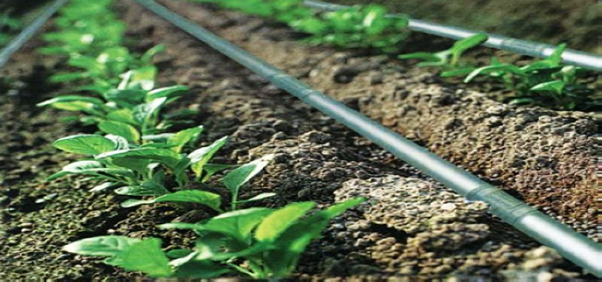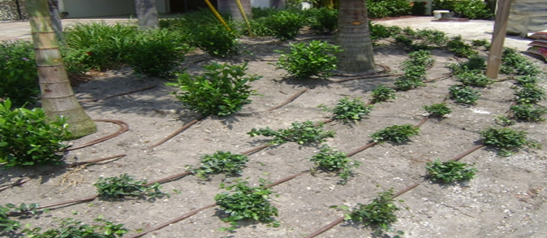Authors: BOLLAVENI SATHISH KUMAR1*, J. RAVINDER2, AKHILESH KUMAR GUPTA1, BAVAJIGUDI SHOBHA RATHOD3
1Department of Agronomy, Sardar Vallabhbhai Patel University of Agriculture & Technology, Meerut, Uttar Pradesh, India.
2 Department of Soil Science and Agricultural Chemistry, Dr.Panjab Rao Deshmukh Krishi Vidyapeeth, Akola, Maharashtra, India.
3 Department of Agronomy, Tamil Nadu Agricultural University, Coimbatore, Tamil Nadu, India.
*Corresponding author's email: sathishbollaveni44@gmail.com
Drip irrigation is sometimes called trickle irrigation and involves dripping water onto the soil at very low rates (2-20 litres/hour) from a system of small diameter plastic pipes fitted with outlets called emitters or drippers. Water is applied close to plants so that only part of the soil in which the roots grow is wetted, unlike surface and sprinkler irrigation, which involves wetting the whole soil profile. With drip irrigation water, applications are more frequent (usually every 1-3 days) than with other methods and this provides a very favourable high moisture level in the soil in which plants can flourish
Suitable crops
Drip irrigation is most suitable for row crops like (vegetables, soft fruit), tree and vine crops where one or more emitters can be provided for each plant. Generally only high value crops are considered because of the high capital costs of installing a drip system.

Suitable slopes
Drip irrigation is adaptable to any farmable slope. Normally the crop would be planted along contour lines and the water supply pipes (laterals) would be laid along the contour also. This is done to minimize changes in emitter discharge as a result of land elevation changes.

Suitable soils
Drip irrigation is suitable for most soils. On clay soils water must be applied slowly to avoid surface water ponding and runoff. On sandy soils higher emitter discharge rates will be needed to ensure adequate lateral wetting of the soil.
Suitable irrigation water
One of the main problems with drip irrigation is blockage of the emitters. All emitters have very small waterways ranging from 0.2-2.0 mm in diameter and these can become blocked if the water is not clean. Thus it is essential for irrigation water to be free of sediments. If this is not so then filtration of the irrigation water will be needed.
Blockage may also occur if the water contains algae, fertilizer deposits and dissolved chemicals which precipitate such as calcium and iron. Filtration may remove some of the materials but the problem may be complex to solve and requires an experienced engineer or consultation with the equipment dealer.
Drip irrigation is particularly suitable for water of poor quality (saline water). Dripping water to individual plants also means that the method can be very efficient in water use. For this reason it is most suitable when water is scarce.
Advantages of Drip Irrigation
The advantages of drip irrigation are as follows
• Water is used at maximum level.
• As water is applied locally and leaching is reduced, fertilizer/nutrient loss is minimized.
• Weeds can not absorb water as no water is available for them.
• Yield of crops are maximum.
• Fertilizers can be used with high efficiency.
• Weed are grown in less number.
• Operational cost is low.
• Soil erosion is not taken place.
• Soil infiltration capacity is increased.
• Fertilizers and ground water is not mixed.
• Seed germination is improved.
• We can use recycled water safely.
• It is not necessary to level the fields.
• We can irrigate water in irregular shaped lands.
• Waste of fertilizers are lessen.
• Energy cost is reduced as it is operated in lower pressure than other irrigation methods.
Disadvantages of Drip Irrigation
Disadvantages of drip irrigation are as follows:
• Expense specially initial cost is high.
• The lifetime of the tubes used in drip irrigation can be shortened by the sun causing wastage.
• May cause clogging if water is not filtered correctly.
• Problems in moisture distribution.
• Salinity problem.
• Germination problem.
• High skills are required.
About Author / Additional Info:
I am currently pursuing Ph.D in Agronomy from University of Assam agricultural university.